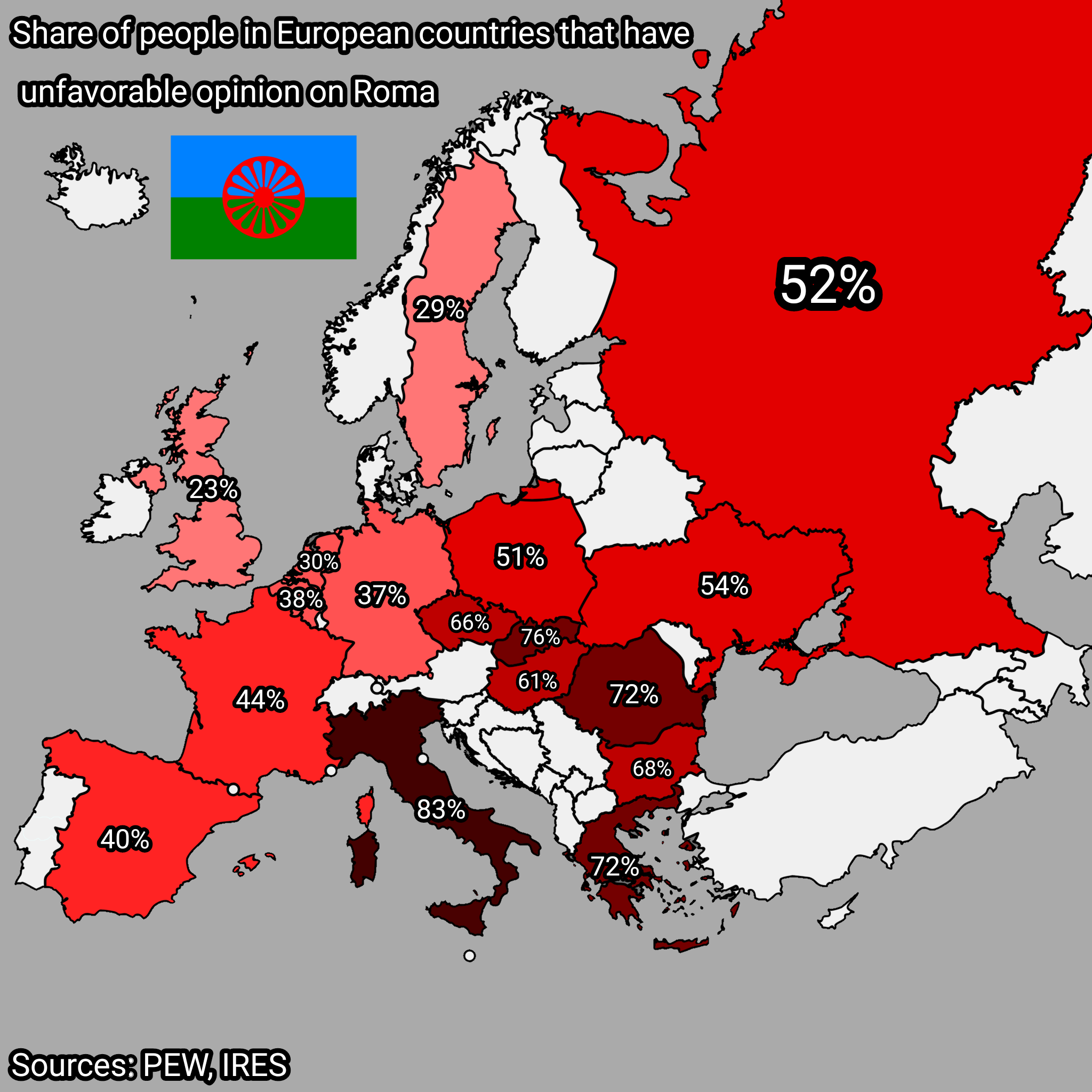Map of Unfavorable Opinions on Roma People in Europe


Marcus Rodriguez
Historical Geography Expert
Marcus Rodriguez specializes in historical cartography and geographic data analysis. With a background in both history and geography, he brings unique...
Geographic Analysis
What This Map Shows\nThis map illustrates the share of individuals in Europe who hold unfavorable opinions about the Roma people, a historically marginalized ethnic group. The visualization highlights stark differences in attitudes across various European countries, drawing attention to the social dynamics and prejudices that persist in modern society. Understanding these sentiments is crucial for addressing discrimination and promoting inclusivity.
Deep Dive into Attitudes Toward the Roma People\nThe Roma people, often referred to as Romani or Gypsies, have a rich cultural heritage and history that spans centuries. However, they have frequently faced systemic discrimination and social ostracism throughout Europe. According to various studies, including those conducted by the European Union Agency for Fundamental Rights, there is a significant correlation between unfavorable opinions about the Roma community and broader issues of social exclusion and ethnic discrimination.
Interestingly, the perceptions of the Roma vary widely across Europe. In some countries, such as Hungary and Slovakia, negative attitudes are prevalent, with a considerable percentage of the population expressing biases against the Roma. This can be attributed to historical stereotypes and socio-economic factors that contribute to the marginalization of Roma communities. For instance, in Hungary, surveys have shown that around 60% of respondents hold unfavorable views about the Roma, tying these perceptions to higher crime rates and social concerns, despite evidence that these stereotypes are largely unfounded.
On the other hand, countries like Portugal and Spain exhibit more favorable opinions towards the Roma, partly due to more integrated policies and efforts aimed at promoting cultural understanding and acceptance. The Roma in these regions have made significant cultural contributions, influencing music, dance, and art. In fact, Flamenco music in Spain has roots in Romani culture, showcasing the rich tapestry of influences that make up European heritage.
The map not only reveals these complex attitudes but also highlights the need for continued education and awareness. The deep-seated biases against the Roma can lead to significant social consequences, such as exclusion from employment opportunities, housing discrimination, and limited access to education and healthcare.
Regional Analysis\nWhen examining the map closely, it becomes evident that Eastern Europe exhibits higher levels of unfavorable opinions toward the Roma compared to Western Europe. For example, while 60% of Hungarians may hold negative views, in countries like Sweden and Denmark, this figure drops significantly to around 10-15%.
The reasons for these discrepancies are multi-faceted. Eastern European countries have a long history of Roma settlement, but also of social and economic strife post-communism, which intensified prejudices. In contrast, Western European nations have experienced different migration patterns and have implemented more robust anti-discrimination laws and policies, resulting in a more tolerant public perception.
Moreover, countries like Italy, which also have significant Roma populations, present a mixed picture. In urban areas, where Roma are more visible, negative opinions can be higher, influenced by socio-economic disparities. However, rural areas might show lesser degrees of bias due to less interaction with Roma communities.
Significance and Impact\nUnderstanding the unfavorable opinions on the Roma people is not just an academic exercise; it has real-world implications for policy-making, community relations, and social cohesion. These attitudes can shape legislation, influence local and national policies, and ultimately affect the lives of millions of Roma individuals living in Europe today.
What's fascinating is that addressing these negative perceptions can lead to significant improvements in social inclusion. For instance, initiatives aimed at improving education and employment opportunities for Roma people have been shown to foster better community relations and reduce prejudices. Organizations like the Council of Europe work tirelessly to promote Roma rights, aiming to break the cycle of discrimination and social exclusion.
In conclusion, the attitudes represented in this map underscore the importance of ongoing dialogue and education regarding the Roma community. As Europe continues to grapple with issues of migration, integration, and diversity, understanding these sentiments will be crucial for fostering a more inclusive society. Have you noticed how perceptions can change with greater awareness and interaction? The journey toward acceptance and understanding is ongoing, and it starts with acknowledging the biases that exist today.
Visualization Details
- Published
- August 8, 2025
- Views
- 210
Comments
Loading comments...